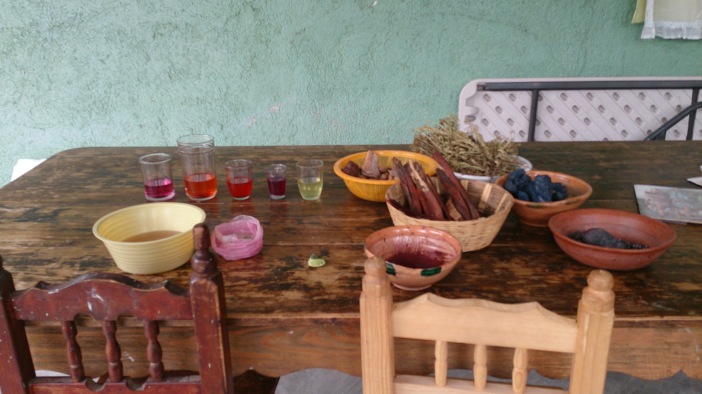Teotitlan de Valle is a weaving village outside of the city of Oaxaca. Of all our stops through Mexico, this was the one I looked forward to the most and was certainly the most inspiring. It’s a pretty insular village that is populated by the Zapotec people. They have a very long tradition of processing, dyeing and weaving wool. Weavers continue the methods they have used for hundreds of years. If it ain’t broke don’t fix it, I suppose.
We took a collectivo (a shared taxi) and started seeing rugs outside houses on the drive to the village. We got a tip to go as far into town as we could for not only the best prices, but also for fair payment. I am certainly not the most knowledgeable about the payment practices for artisans in that region (or any), but I did know that I wanted to buy from as close to the original weaver I could. I also desperately wanted to find someone who would show me the weaving process. Once we got to the center square we wandered around a bit and I was like a kid in a candy store because just about every building had some sort of handmade wool item hanging outside. We walked into a couple showrooms and saw some incredible rugs and hangings. There were a few that must have been 15 x 15. The amount of work and skill that goes into each rug is astounding.
We walked through town and Aaron saw a sketchy looking metal door that had a tiny sign saying that it was a women’s weaving cooperative. I am not gonna lie, I was a little nervous that it was a ploy to kidnap and ransom us, but Aaron is braver (and more rational) than I. So he banged on the door. A perfectly nice lady opened it and offered to show us around the coop. IT WAS UNREAL. There was a courtyard with a couple families doing laundry, chickens pecking around (standard), and women processing wool.
My Spanish is not even at a mediocre level but I took a lot of years of French and can understand a decent amount of Spanish because so many verbs are similar. However, I can’t really speak at all. Aaron tried his best to translate my many, many, questions and I am grateful to both him and the woman who showed us around. They were very patient with me, who was more or less foaming at the mouth.
The women buy raw wool at the market each week in huge rice bags. They scour and card it all by hand, which itself is a huge endeavor. Then they spin it all into what looked like a single ply, and dye it. There is a resurgence of natural dyes being used by the Zapotecs. They originally used plants and insects, but moved toward synthetic dyes during the last century. Recently many weavers have gone back to their roots and are using only natural dyes again. We got a tutorial of what they use for dyes, and were shown how different the shades can be depending on acidity and concentration of dye. Some of the dyes I didn’t get the English names of, but they used a type of bark, some plants I wasn’t familiar with, indigo and the cochineal insect. I felt so lucky to be shown their methods and dyes.


And the rugs. I keep saying they were incredible but they really were. They use huge pedal looms that they more or less stand inside in order to operate. They are enormous.

 The cooperative we went to is called Vida Nueva . The women that are part of the cooperative are either single women and mothers, or widows. The cooperative allows them to look out for each other and to improve the lives of the women in the village. They also sell directly to their customers, cutting out middle men and keeping more of the money they have rightly earned. I can’t find a website for them but the link above describes their process and organization. This link is worth clicking also, it’s a great video interview with some of the women.
The cooperative we went to is called Vida Nueva . The women that are part of the cooperative are either single women and mothers, or widows. The cooperative allows them to look out for each other and to improve the lives of the women in the village. They also sell directly to their customers, cutting out middle men and keeping more of the money they have rightly earned. I can’t find a website for them but the link above describes their process and organization. This link is worth clicking also, it’s a great video interview with some of the women.
I would have loved to buy a giant or even medium sized rug but alas we had neither the money nor the space. I bought a small indigo dyed rug for 200 pesos. AND I LOVE IT.
